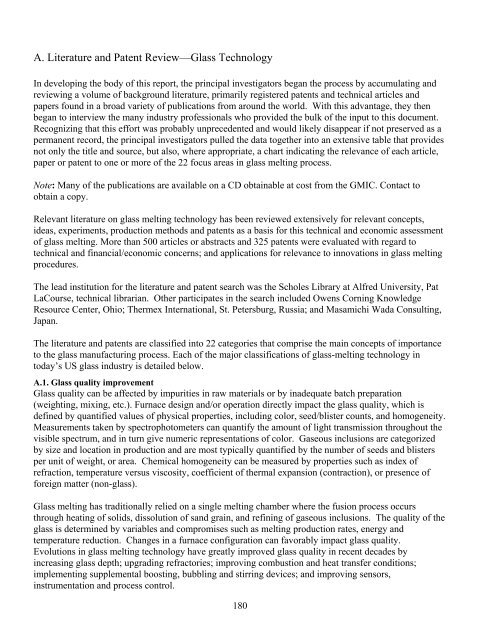Glass Melting Technology: A Technical and Economic ... - OSTI
Glass Melting Technology: A Technical and Economic ... - OSTI
Glass Melting Technology: A Technical and Economic ... - OSTI
Create successful ePaper yourself
Turn your PDF publications into a flip-book with our unique Google optimized e-Paper software.
A. Literature <strong>and</strong> Patent Review—<strong>Glass</strong> <strong>Technology</strong><br />
In developing the body of this report, the principal investigators began the process by accumulating <strong>and</strong><br />
reviewing a volume of background literature, primarily registered patents <strong>and</strong> technical articles <strong>and</strong><br />
papers found in a broad variety of publications from around the world. With this advantage, they then<br />
began to interview the many industry professionals who provided the bulk of the input to this document.<br />
Recognizing that this effort was probably unprecedented <strong>and</strong> would likely disappear if not preserved as a<br />
permanent record, the principal investigators pulled the data together into an extensive table that provides<br />
not only the title <strong>and</strong> source, but also, where appropriate, a chart indicating the relevance of each article,<br />
paper or patent to one or more of the 22 focus areas in glass melting process.<br />
Note: Many of the publications are available on a CD obtainable at cost from the GMIC. Contact to<br />
obtain a copy.<br />
Relevant literature on glass melting technology has been reviewed extensively for relevant concepts,<br />
ideas, experiments, production methods <strong>and</strong> patents as a basis for this technical <strong>and</strong> economic assessment<br />
of glass melting. More than 500 articles or abstracts <strong>and</strong> 325 patents were evaluated with regard to<br />
technical <strong>and</strong> financial/economic concerns; <strong>and</strong> applications for relevance to innovations in glass melting<br />
procedures.<br />
The lead institution for the literature <strong>and</strong> patent search was the Scholes Library at Alfred University, Pat<br />
LaCourse, technical librarian. Other participates in the search included Owens Corning Knowledge<br />
Resource Center, Ohio; Thermex International, St. Petersburg, Russia; <strong>and</strong> Masamichi Wada Consulting,<br />
Japan.<br />
The literature <strong>and</strong> patents are classified into 22 categories that comprise the main concepts of importance<br />
to the glass manufacturing process. Each of the major classifications of glass-melting technology in<br />
today’s US glass industry is detailed below.<br />
A.1. <strong>Glass</strong> quality improvement<br />
<strong>Glass</strong> quality can be affected by impurities in raw materials or by inadequate batch preparation<br />
(weighting, mixing, etc.). Furnace design <strong>and</strong>/or operation directly impact the glass quality, which is<br />
defined by quantified values of physical properties, including color, seed/blister counts, <strong>and</strong> homogeneity.<br />
Measurements taken by spectrophotometers can quantify the amount of light transmission throughout the<br />
visible spectrum, <strong>and</strong> in turn give numeric representations of color. Gaseous inclusions are categorized<br />
by size <strong>and</strong> location in production <strong>and</strong> are most typically quantified by the number of seeds <strong>and</strong> blisters<br />
per unit of weight, or area. Chemical homogeneity can be measured by properties such as index of<br />
refraction, temperature versus viscosity, coefficient of thermal expansion (contraction), or presence of<br />
foreign matter (non-glass).<br />
<strong>Glass</strong> melting has traditionally relied on a single melting chamber where the fusion process occurs<br />
through heating of solids, dissolution of s<strong>and</strong> grain, <strong>and</strong> refining of gaseous inclusions. The quality of the<br />
glass is determined by variables <strong>and</strong> compromises such as melting production rates, energy <strong>and</strong><br />
temperature reduction. Changes in a furnace configuration can favorably impact glass quality.<br />
Evolutions in glass melting technology have greatly improved glass quality in recent decades by<br />
increasing glass depth; upgrading refractories; improving combustion <strong>and</strong> heat transfer conditions;<br />
implementing supplemental boosting, bubbling <strong>and</strong> stirring devices; <strong>and</strong> improving sensors,<br />
instrumentation <strong>and</strong> process control.<br />
180

















